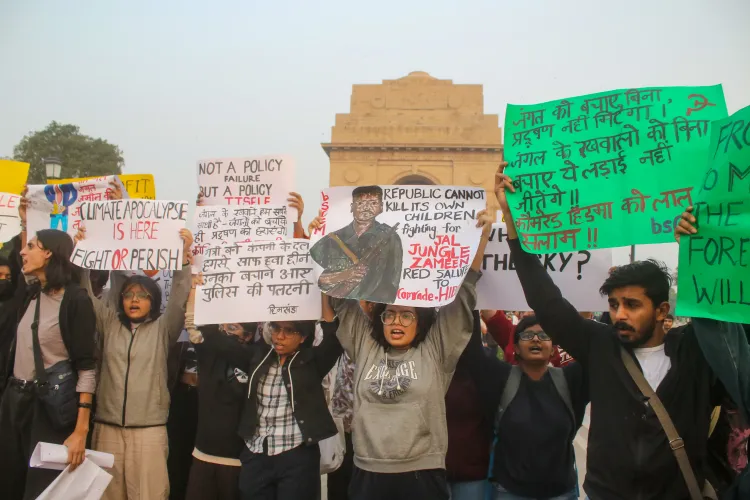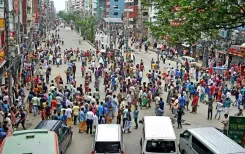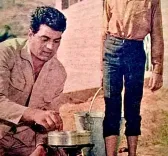What Happened During the Delhi Pollution Protest?

Synopsis
Key Takeaways
- 22 people arrested for using pepper spray against police.
- Protest against worsening air quality in Delhi-NCR.
- Government revising policies to combat pollution.
- Air quality levels reaching ‘severe’ in various areas.
- Increased public frustration leading to protests.
New Delhi, Nov 24 (NationPress) Twenty-two individuals were taken into custody for reportedly using pepper spray against police officers after law enforcement attempted to clear a group obstructing a roadway at India Gate's C-Hexagon during a demonstration aimed at protesting against the escalating pollution levels in the Delhi-NCR region, officials confirmed on Monday.
The protestors gathered on Sunday evening, chanting slogans regarding the worsening air quality in the national capital. Tensions escalated when some demonstrators allegedly resorted to using pepper spray during a confrontation with the police.
Two FIRs have been lodged regarding this incident, with the Delhi Police applying various relevant sections. Reports indicate that an FIR was filed leading to the arrest of approximately 22 individuals for allegedly deploying pepper spray on police personnel, obstructing official duties, and blocking a public thoroughfare.
At the Kartavya Path Police Station, six male protestors were detained under BNS Sections 74, 79, 115(2), 132, 221, 223, and 61(2). A second FIR was registered at Sansad Marg Police Station, where additional protestors were taken into custody under BNS Sections 223A, 132, 221, 121A, 126(2), and 3(5).
Officials reported that several protestors had moved into the C-hexagon area and attempted to breach barricades established to manage traffic flow.
Police explained that ambulances and medical teams were trapped behind the blockade and required immediate access, but the protestors allegedly became “agitated”.
With concerns of escalating tensions, officers advised the protestors to retreat. However, the protestors disregarded these instructions, broke through the barricades, entered the roadway, and sat down, prompting police intervention.
The group was subsequently removed from the C-hexagon to avert further traffic disruptions in this busy area.
This incident transpired shortly after several individuals were detained on November 9 at India Gate during a “clean air protest,” wherein participants demanded immediate government action and stricter policies to address what they termed an “air emergency” in the national capital.
The ongoing protests coincide with a decline in visibility across various parts of the city as the toxic haze thickens, leading to renewed health warnings from authorities.
Nearby NCR cities are also facing deteriorating air quality, with Faridabad reporting an AQI of 358, Gurugram at 370, Ghaziabad at 355, Greater Noida at 342, and Noida at 372.
While most areas in Delhi are experiencing AQI levels between 300 and 400, certain pockets have already exceeded the 400 mark, entering the ‘severe’ category. Officials have warned that conditions may worsen if wind speeds remain low.
In response to rising pollution levels, the Commission for Air Quality Management for NCR and surrounding areas revised the Graded Response Action Plan on Saturday.
In their press release, the CAQM stated that measures previously reserved for the ‘severe’ category under GRAP Stage IV will now be implemented at Stage III.
These measures include ensuring uninterrupted power supply to minimize diesel generator usage, deploying additional personnel at traffic congestion hotspots, issuing pollution alerts through various media, and expanding CNG and electric public transport fleets with increased service frequency and differential fares to encourage off-peak travel.
Several measures that were previously categorized under Stage III for ‘very poor’ air quality have now been reassigned to Stage II, including staggered working hours for government offices in Delhi, Gurugram, Faridabad, Ghaziabad, and Gautam Buddh Nagar.
The Central government may also consider implementing staggered timings for its offices in the region.
Restrictions that were previously intended for Stage IV during severe AQI, such as limiting public, municipal, and private offices to operating with only 50% of their staff and requiring the remaining employees to work from home, will now be applicable at Stage III.
Meanwhile, the Delhi government has instructed private offices to function with 50% on-site personnel and allow the remaining employees to work from home as a precautionary measure, as the capital continues to grapple with worsening air quality.








